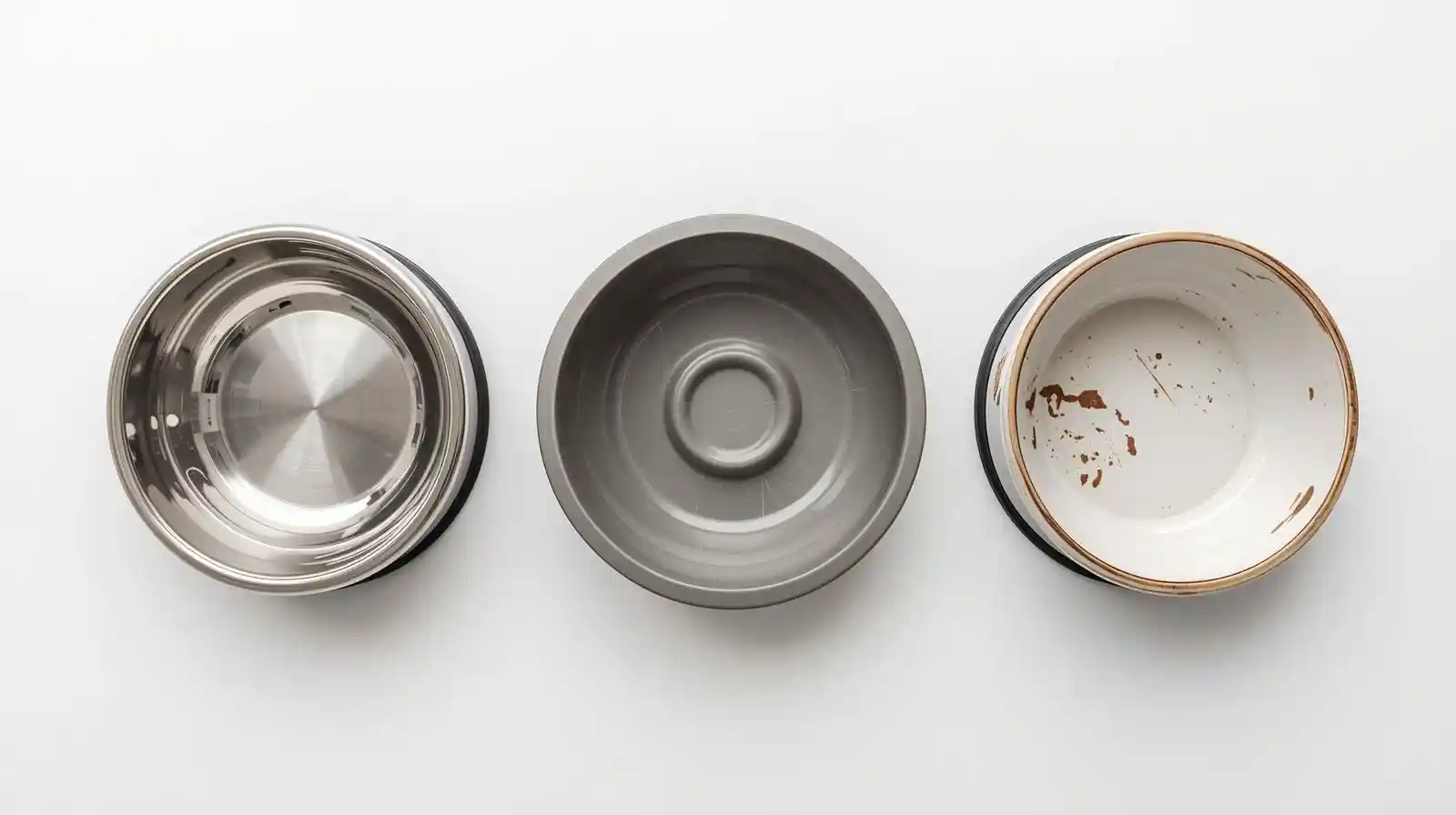Choosing the right bowl material is one of those small decisions that can make a big difference in a dog’s health, comfort, and even household cleanliness. In the realm of Dog Bowl Materials → Comparative Analysis → Stainless Steel vs Alternatives, this article explores how stainless steel stacks up against plastic and ceramic dog bowls. The goal is to help a dog owner decide which material is best in their situation.
Why Bowl Material Matters
Before comparing, it helps to understand what matters:
- Hygiene & safety — bacteria growth, harmful chemicals, toxins
- Durability & wear — cracks, scratches, brittleness
- Ease of cleaning & maintenance
- Practical use & behavior — sliding, tipping, mess, weight
- Cost & aesthetic appeal
Veterinary authorities and pet care experts consistently highlight those aspects. (AKC)
What Each Material Offers: Stainless Steel, Plastic, Ceramic
Here is a side-by-side of what each material generally offers, before diving into stainless steel vs plastic and ceramic.
| Material | Main Advantages | Main Disadvantages |
|---|---|---|
| Stainless Steel | Very durable; non-porous surface resists bacteria; safe in dishwashers; doesn’t absorb odors; minimal chemical risk; often recommended by vets. |
Lightweight models can slide or tip; noisy; may look utilitarian rather than decorative; lower-quality steel or finishes may corrode or have less resistance. |
| Plastic | Affordable; lightweight; plentiful design choices; easy to carry/travel with; often good for temporary or backup use. |
Scratches easily; scratches can trap bacteria; may harbor odors; chemical leaching (BPA, phthalates) is a concern; some dogs may get skin irritation or chin acne. |
| Ceramic | Heavier, stable (less likely to slide); many styles, decorative/glazed look; often pleasing in home décor; good alternative for dogs with metal sensitivities. |
Can chip or crack; micro-cracks can trap bacteria; glazing may contain lead or toxins if low quality; breakage risk; heavier to handle; possible dishwasher-fragile depending on glaze or manufacturing. |
Stainless Steel vs Plastic Dog Bowls
Let’s compare stainless steel and plastic more directly in the context of everyday use:
Hygiene & Safety
- Stainless steel is non-porous, meaning food residues, bacteria, or odors do not soak in. It’s easier to sanitize via dishwasher or boiling water.
- Plastic, especially lower quality kinds, can develop fine scratches quickly. Those scratches become micro-environments for bacteria. Also chemicals like BPA or phthalates may be present and could leach into food or water over time.
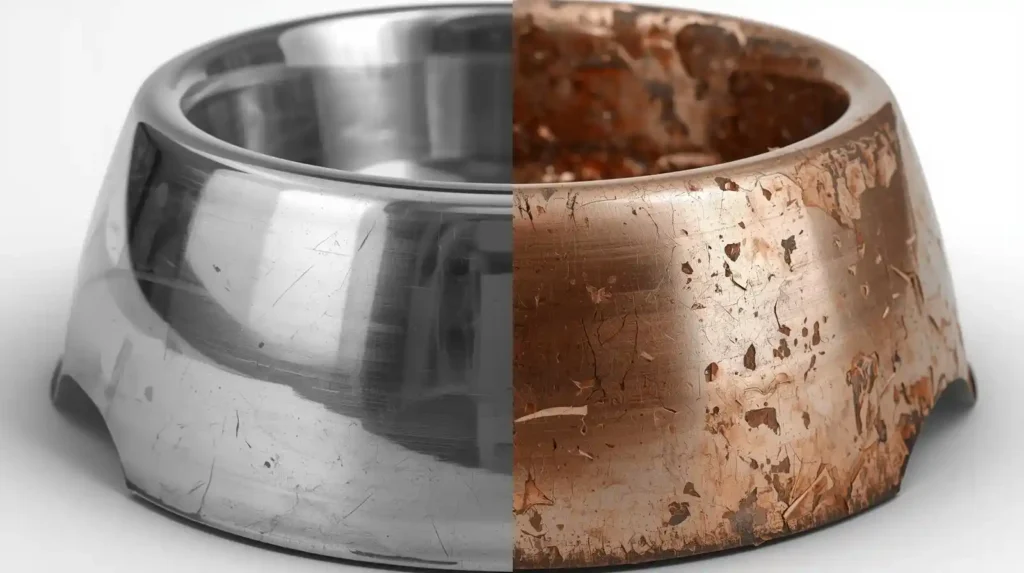
Durability & Lifespan
- Stainless steel tends to last longer. It’s resistant to denting, breaking, or degrading with repeated cleaning. Even though some lightweight steel bowls may warp or scratch, those are often cosmetic.
- Plastic’s lifespan is shorter. Scratches, warping, chewing by some dogs, and chemical degradation (especially under heat or sunlight) reduce its useful life. Owners often need to replace plastic bowls more frequently.
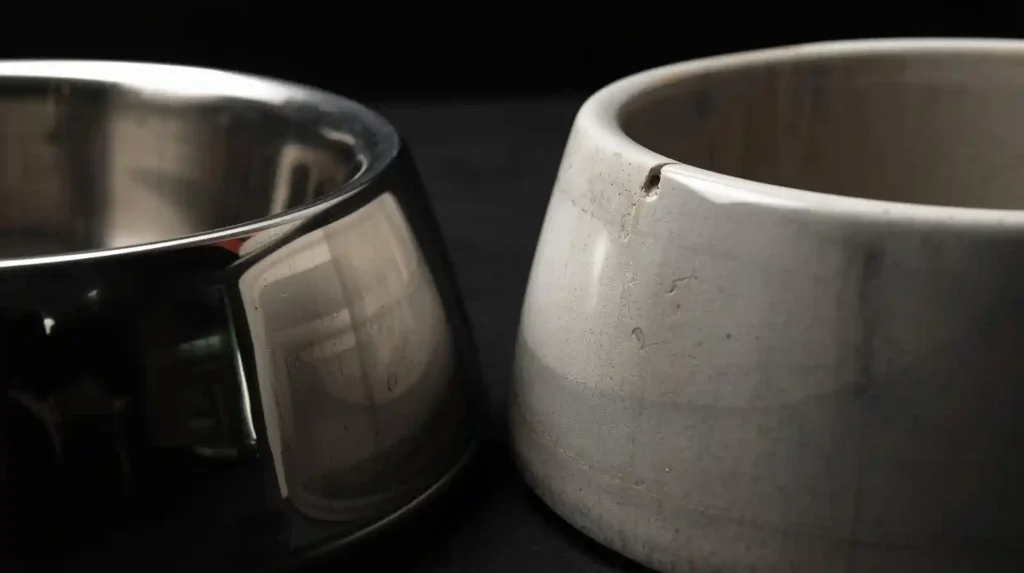
Practical Use & Behavior
- Stainless steel bowls can be noisy (metal clanks, tags hitting sides) and may slide unless a rubber or non-slip base is used. For an energetic or messy eater, this can matter. (Seaport Animal Hospital)
- Plastic bowls are lightweight, so easier for dogs to tip or carry. But for travel or backup use, that lightweight quality is a benefit. Also, plastic bowls come in many shapes and styles (e.g. travel, collapsible, double bowls) more affordably.
Cost & Long-Term Value
- Upfront cost for stainless steel is higher than very cheap plastic. But when factoring replacement frequency, hygiene, and health risks, steel is often more cost-effective.
- Plastic may cost less initially but hidden costs (replacement, cleaning, potential health issues) can add up. Particularly if you buy multiple cheap plastic bowls over time.
Stainless Steel vs Ceramic Dog Bowls
Now, comparing stainless steel to ceramic:
Aesthetic & Design
- Ceramic scores high in beauty: color, style, glazes, decorative designs that make dog bowls part of home décor. For dog owners who care about matching their furniture or kitchen, ceramic wins here.
- Stainless steel is more functional: cleaner lines, utilitarian looks. Less variety in decoration, though finishes and bowls with colored bases can help. A stone cold steel look may feel less “homely” to some.
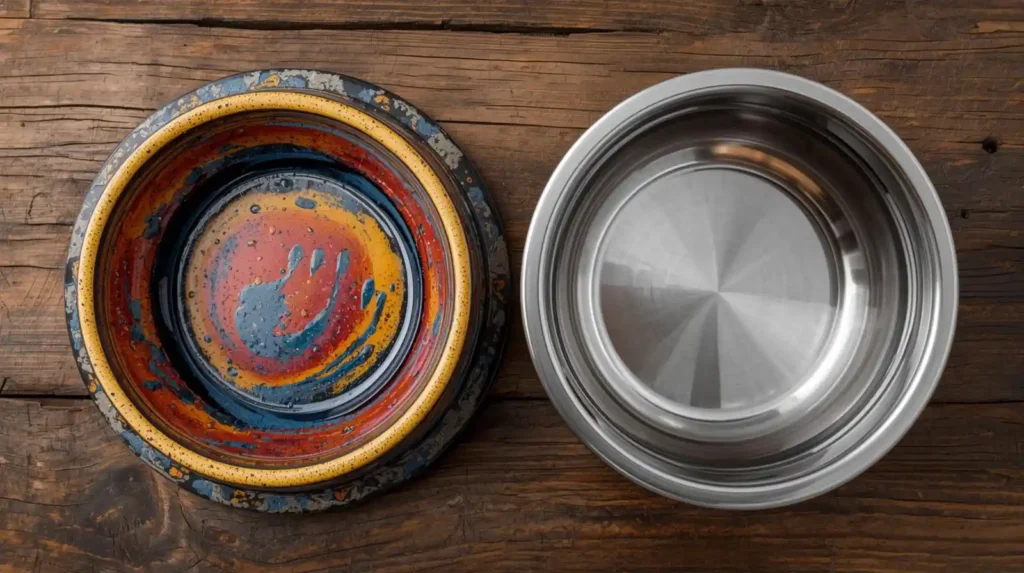
Safety & Chemical Risks
- Ceramic glazes: If of poor quality or not certified, they may contain lead or other heavy metals that can leach, especially in acidic or moist conditions. Glazes can wear down over time.
- Stainless steel avoids that risk. There is minimal concern about metal leaching if it’s food-grade stainless steel (e.g. 304 grade). Some rare cases of dogs with metal sensitivities exist, but generally negligible compared to glazed ceramic risks.
Durability, Wear & Breakage
- Ceramic can chip or crack. Even hairline cracks that are hard to see can trap bacteria. Once damage happens, ceramic’s protective glaze is compromised.
- Stainless steel resists that kind of damage. It won’t chip or crack, though it can scratch or dent. Scratches in steel are less of a hygiene hazard if shallow, because steel remains non-porous.
Cleaning & Maintenance
- Stainless steel is generally easier to clean: dishwasher safe, resilient to high temperature, fewer concerns about damaging the material during cleaning.
- Ceramic may or may not be dishwasher safe depending on how it’s glazed. Also, heavy bowls may be harder to move/wash manually. Need to inspect glaze regularly.
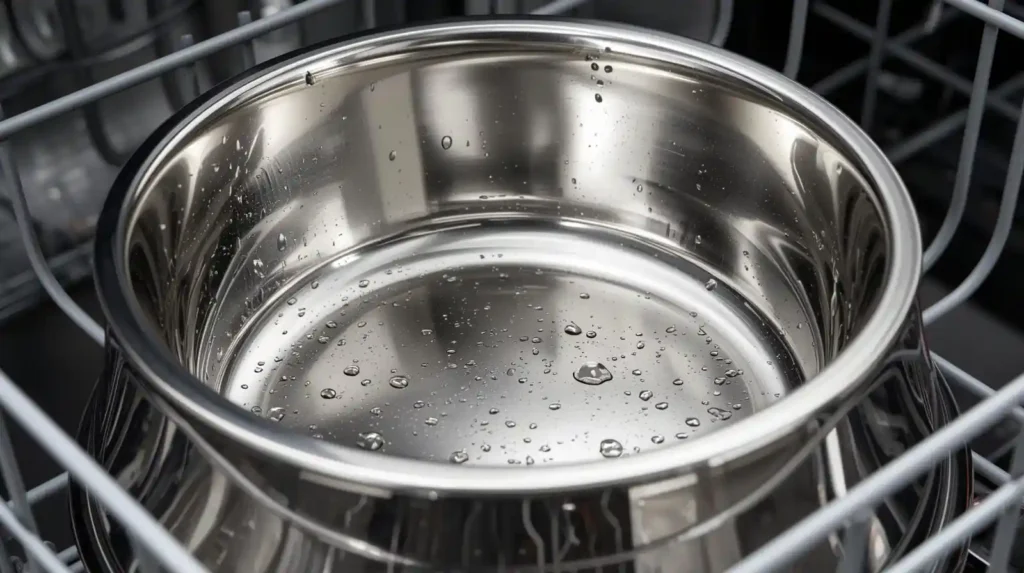
Weight & Stability
- Ceramic tends to be heavier, which is a plus if your dog pushes or tips the bowl. It stays more stable. Good for larger dogs or dogs that tend to “play” with their bowls.
- But heavy bowls are harder to transport or clean, and risk more damage if dropped.
When Stainless Steel Is the Best Choice
Given those comparisons, stainless steel emerges as the best “default” option in many circumstances. The following use-cases illustrate when stainless steel is clearly preferable:
- Everyday feeding — for both food and water, especially wet food or raw food diets, where hygiene is critical.
- Homes with multiple dogs — more feeding bowls, more risk of mess, so durability and ease of cleaning matter more.
- Outdoor use or travel — steel resists weather, rust (if high grade), and generally cleans well.
- Dogs with skin issues / allergies — if plastic irritates the chin or if there’s concern about ceramic glaze, steel is safer.
- Budget over time — paying more once for steel may cost less vs replacing plastic or replacing broken ceramic bowls.
When Plastic or Ceramic May Be Preferable
There are situations where plastic or ceramic might win:
- Low cost & portability needs — plastic excels for travel, camping, temporary setups.
- Design / home décor importance — when the bowl is visible and style matters, ceramic gives options that steel often doesn’t.
- Heavy, stable bowl needed — ceramic bowls are less likely to slide around for playful dogs or large breeds.
- Metal sensitivity — if a dog (rarely) has a reaction to stainless steel or nickel components.
Key Qualities to Look For in Any Material
Regardless of which material is chosen, some features reduce risk and improve value:
- Food-grade or pet-safe certification: e.g. stainless steel grade labeled (304, 18/8), plastic labeled BPA-free, ceramic glaze lead-free.
- Non-slip or rubber base to minimize sliding.
- Dishwasher safe or easy to clean with hot soapy water.
- Inspect regularly for damage (cracks, chips, deep scratches). Replace if damaged.
- Size and shape appropriate for your dog’s breed, eating style (shallow for flat muzzled, deeper for long muzzled).
Integration with Related Reading
For those wanting deeper dives:
- To explore more about the properties, uses, and selection of stainless steel, see The Ultimate Guide to Stainless Steel Dog Bowls.
- For understanding safety implications in more detail, check Are Stainless Steel Dog Bowls Safe for Your Pet?.
- For a broader view of benefits and drawbacks, The Pros and Cons of Stainless Steel Dog Bowls offers additional perspectives.
Bottom Line: Stainless Steel vs Plastic & Ceramic Dog Bowls
In comparing stainless steel vs plastic and ceramic dog bowls, stainless steel is often the safest, most hygienic, and most durable material. Plastic and ceramic each have their places, depending on preferences for aesthetics, cost, or specific use cases, but come with trade-offs:
- Plastic: most affordable, but highest maintenance and risk
- Ceramic: aesthetic and stable, but fragile and potential chemical risk if poor quality
- Stainless steel: best general-purpose choice, lowest long-term risk, best hygiene
Dog owners who want minimal fuss, highest cleanliness, and long lifespan will often lean toward stainless steel. Those who prioritize design, décor, or use bowls situationally may mix materials or accept drawbacks.
FAQs
-
Is stainless steel safe for dogs with food allergies or skin sensitivities?
Yes — stainless steel is generally inert and non-porous, which means fewer allergens or residues remain after cleaning. If a dog is sensitive to nickel or certain metals, choosing a well-grade 304 (18/8) stainless steel bowl helps reduce risk. -
Can cheap stainless steel rust or corrode?
Low-quality stainless steel or bowls with poor finish can show rust or discoloration, especially if scratched or if exposed continuously to moisture. But food-grade stainless steel (304, 18/8) resists rust much better. Proper care (drying, avoiding abrasive cleaners) helps. -
How often should I replace a ceramic bowl?
Replace it if you notice any chips, cracks, or damage to the glaze. Even tiny, invisible cracks can harbor bacteria. Depending on quality and use, this might be every year or even sooner for some dogs. -
Are BPA-free plastic bowls safe for long-term use?
Even BPA-free plastics can develop scratches and harbor bacteria. While safer than plastics with BPA, they still have higher maintenance and shorter lifespan compared to stainless steel. -
Does the weight of a bowl matter?
Yes. Heavy bowls (ceramic or weighted steel) resist tipping and sliding, especially useful for large, strong, or excited eaters. Lightweight bowls are easy to move, carry, or store. -
Do ceramic bowl designs wear off?
Decorative glazes can fade or crack over time. The glaze is crucial for sealing; loss of glaze or damage exposes the ceramic underneath, increasing risk of bacteria or even ingestion of harmful materials if glaze had toxins. -
Are there environmental impacts to consider?
Yes. Stainless steel has high energy cost in production, but often lasts much longer, reducing replacement waste. Plastic has environmental disposal issues. Ceramic production can also have environmental costs, and broken pieces are harder to recycle. -
What’s the best bowl material for travel or outdoor use?
For portability, lightweight plastic or lightweight stainless steel works well. For outdoor feeding stations, stainless steel resists environmental exposure better (rust, weather, pests). Plastic may degrade under sun/heat. -
How important is cleaning frequency?
Very important. Regardless of material, bowls should be washed daily (especially with wet food) and water bowls refreshed often. Stainless steel tolerates hot water and dishwashers better; plastic and ceramic need more gentle care, inspection, and sometimes handwashing to maintain safety.

